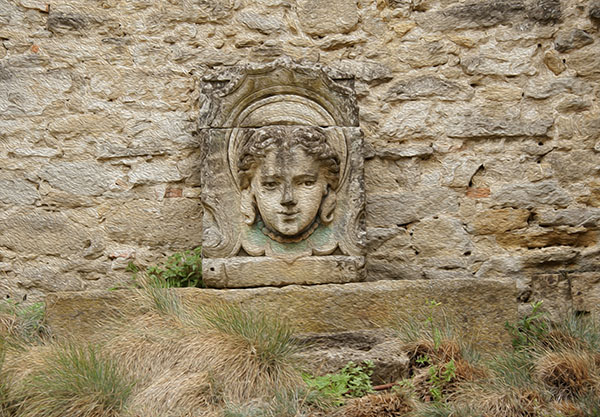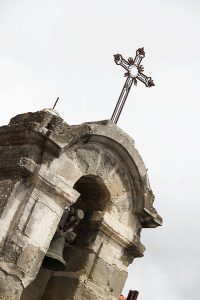Narrow streets and alleyways with the aged doors of buildings at times exhibiting dates denoting their age, it was a town worth wandering through.
The buildings themselves were a mix of sepia tones and brightly coloured.
Intricately designed wrought iron gates led into an old manor house that was undergoing renovations,
and well worn the steps of the church had one realising the feet of thousands had trod upon them.
What a history Castlenaudary had!!!!
The name itself was created combining the Occitan and Basque languages: ‘Castelnou’ (new castle) from the former and ‘ary’ (stone) from the latter.
Positioned on the plain of Lauragais in the cradle of Catharism, with the foothills of the Black Mountains to the north and those of the Pyrenees south, the town is blessed with picturesque panoramic views.
Back in the time of antiquity, then called Sostomagus, the town was just a station post on the Roman road connecting the towns of Tolosa to Narbo. By the second century BC a small Gallic village stood upon the site where the windmill stands today, but this was abandoned during the third century AD.
A castle and the farmland around had replaced the early settlement by the 1100s.
Castelnaudary was in a key position for the battles that took place against the Cathars, a people who formed a religion in opposition to the Catholic Church, in the thirteenth century during what is known as the Albigensian Crusade.
During the Hundred Years War with England, Castelnaudary was attacked, ransacked and destroyed by the army of The Black Prince. Many of its residents were massacred during the process.
We visited the town’s museum (it was undergoing renovation in some areas),
whose history went back to Catherine de Medici who became Countess of Lauragais and declared the town capital of the region. It became the administrative/judicial centre and the building’s structure was altered in order for it to become a jail. Today, local artists displayed their works within its walls.
Besides the art, there were other interesting finds:
a disused fountain in the old courtyard,
a plaque detailing a visit by Thomas Jefferson,
and an old grinding wheel,
This was the find of the day before the rain set in. A small chapel in a small plain building.
What drew our eye was the bell upon the top and a keyed gate across the front. Not the best of shots, but a tricky thing to do with bars in front of the lens, this was the treasure we discovered within.
Despite its bloody history, the town was famous for its Cassoulet (did we try it? No!! Full of fat, sausage, duck and white beans, we were too cholesterol conscious and it simply did not appeal), the yearly ‘Feast of the Cassoulet’, and the Great Basin on the Canal du Midi.
There was a legend behind the Cassoulet. During the 100 year war, the residents of the town were starving as very little food remained. Making the decision to share the last of their provisions – broad beans, pork, bacon, turnips, herbs, spices and so forth – and placing them in terracotta containers called Cassoles, the mighty stew dish was born. During the 1600s, an American bean was introduced and this gradually replaced the vegies, thereby causing the stew to undergo a massive change that turned it into what it has become today.
Another find completed our day: a restored windmill situated on the northern edge of town, and we were fortunate in that it was open for exploring.
Cobblestones surrounded the structure,
against which an aged grinding stone rested,
whilst within, the wooden cogs were there for all to see.
Those working aloft had the best of views.



























